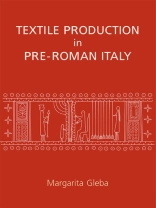Older than both ceramics and metallurgy, textile production is a technology which reveals much about prehistoric social and economic development. This book examines the archaeological evidence for textile production in Italy from the transition between the Bronze Age and Early Iron Ages until the Roman expansion (1000-400 BCE), and sheds light on both the process of technological development and the emergence of large urban centres with specialised crafts. Margarita Gleba begins with an overview of the prehistoric Appennine peninsula, which featured cultures such as the Villanovans and the Etruscans, and was connected through colonisation and trade with the other parts of the Mediterranean. She then focuses on the textiles themselves: their appearance in written and iconographic sources, the fibres and dyes employed, how they were produced and what they were used for: we learn, for instance, of the linen used in sails and rigging on Etruscan ships, and of the complex looms needed to produce twill. Featuring a comprehensive analysis of textiles remains and textile tools from the period, the book recovers information about funerary ritual, the sexual differentiation of labour (the spinners and weavers were usually women) and the important role the exchange of luxury textiles played in the emergence of an elite. Textile production played a part in ancient Italian society’s change from an egalitarian to an aristocratic social structure, and in the emergence of complex urban communities.
Gleba Margarita Gleba
Textile Production in Pre-Roman Italy [PDF ebook]
Textile Production in Pre-Roman Italy [PDF ebook]
Beli ebook ini dan dapatkan 1 lagi GRATIS!
Bahasa Inggris ● Format PDF ● Halaman 280 ● ISBN 9781782976059 ● Penerbit Oxbow Books ● Diterbitkan 2008 ● Diunduh 3 kali ● Mata uang EUR ● ID 3461676 ● Perlindungan salinan Adobe DRM
Membutuhkan pembaca ebook yang mampu DRM












